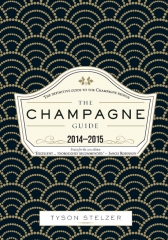The Champagne Guide 2014-2015
| Title of book: | The Champagne Guide 2014-2015 |
| Author: | Tyson Stelzer |
| Publisher: | Hardie Grant Books |
| Publication date: | 2013 |
| ISBN | 978 1 742 705 415 |
| Pages: | 360 |
| Price: | £20.00 hardback / £10.00 ebook |
 Australian wine author Stelzer has updated his guide to Champagne, which is, essentially, a guide to the champagnes the author asserts are worthy of drinking “this year”, for which we are presumably meant to read “during 2014 and 2015”.
Australian wine author Stelzer has updated his guide to Champagne, which is, essentially, a guide to the champagnes the author asserts are worthy of drinking “this year”, for which we are presumably meant to read “during 2014 and 2015”.
All wines are scored on a 15 point scale from 85 to 100, with 85 being “ordinary and boring” and 100 “the pinnacle”. The scale extends, unnecessarily to my mind, to 80 because he says anything below 85 is faulty. It’s not clear if the wines in the 80-84 score were bottle faults (but why didn’t he retaste?), or if they were wine faults that affect the whole batch of production (unlikely). Ah, reading later in the book, the author reveals his campaigning mission. Campaigning against faulty wine is an admirable mission – he touches on faults, though the faults he discusses are common to wines of all styles, sparkling, still and fortified.
There’s a price code banding with equivalences in six currencies. This is for each wine tasted. There’s also a useful at-a-glance house ranking on page 15 which details houses that performed well on Stelzer’s point scale across the range of wines made at each house, typically NV, vintage and prestige cuvées. There’s an equally useful cross-reference page of the best wines listed by price bracket.
The rest of the book, its vast majority – some 85% – lists producers, their profiles and tasting notes. In all, he profiles nearly 100 champagne producers, from the very big (Moët et Chandon, sourcing from an estimated more than 3,000 hectares) to the much smaller (Benoît Lahaye, sourcing from less than 5 ha). Profiles typically outline producer size, philosophy on such things as use of oak and malolactic fermentation and grower/negociant status. Stelzer’s tasting notes are fluid.
However, I fear he may have shot himself in a foot somewhat with his non-vintage (NV) tasting notes. He says the notes refer to “current disgorgements”, i.e. the ‘disgorgements’ (effectively ‘bottlings’, given that disgorgement is the last chance prior to bottle sale that the winemaker has of adjusting the wine) he tasted for the book during the first half of 2013. It is entirely likely that readers during 2014 and 2015 may be drinking wines from more recent ‘disgorgements’. Therefore, not the exact same batch that the author tasted.
While new vintage champagnes are easy to spot on the label, NV champagnes are based on a rolling blend of typically a base vintage plus 1 or 2 other vintages. And the author makes the point that time in bottle from disgorgement can notably influence flavour profile.
It’s great that Stelzer raises the issue of digorgements, and the date of disgorgement appearing on the label (or not), but in doing so, he highlights the nuance of confusion for consumers who may naturally or unwittingly assume every bottle of NV Champagne they buy being exactly the same as the previous one.
Even given that the tasting notes themselves will increasingly become out of date, one can hope that the other details are largely consistent over a longer period, e.g. the broad portions of grape varieties, the components matured in wood, the dosage, and certainly details of particular parcels, where these are mentioned.
Overall, I find the book a bit light on factual detail about the Champagne region and the production complexities that lead to the plethora of styles the author subsequently explores via his tasting notes. I wouldn’t use this as my prime educational tome on Champagne knowledge, though it may make a useful adjunct to the Avellan/Stevenson axis of profundity.



